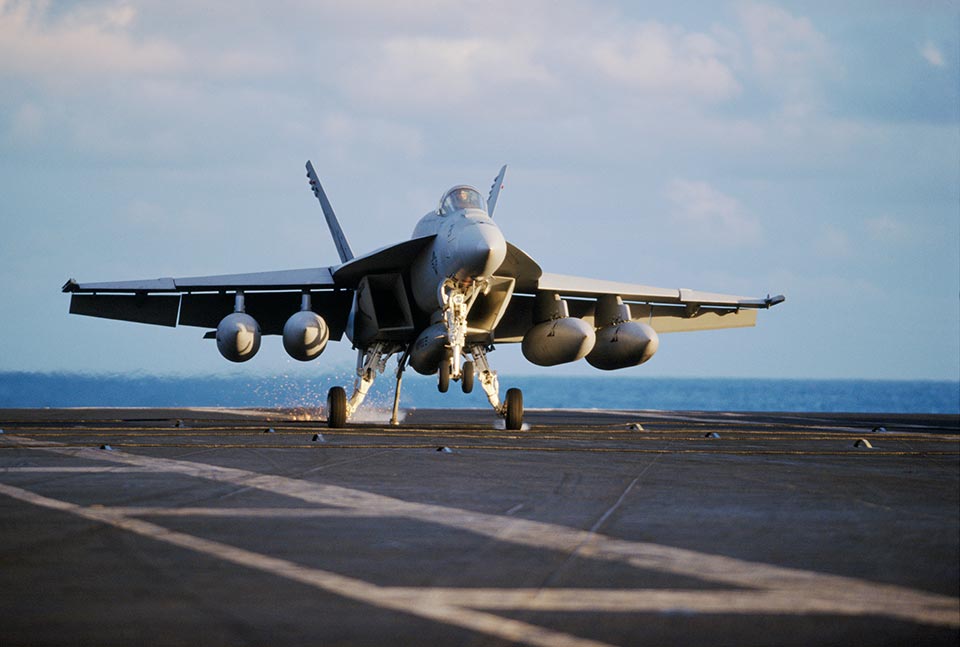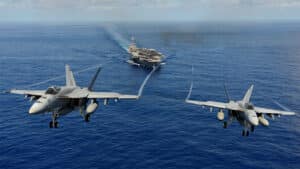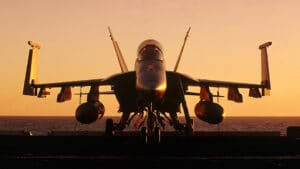Aerospace
These are some of the factors that make the Boeing FA-18 to India a likely strong contender.

The F/A-18 Super Hornet Block III on offer to the Indian Navy is the world’s most advanced, combat proven, multi-role frontline naval fighter that offers unique and differentiated capabilities and full compatibility with Indian Navy carriers.
The F/A-18E/F Block III Super Hornet was designed as a carrier-based fighter for high-load, high-stress operations. It requires little support equipment and has the lowest cost per flight hour to operate with high mission readiness rates. The Block III Super Hornet, being the US Navy’s frontline fighter with over 700 aircraft in service across the world, provides prospects for naval aviation cooperation between the US and Indian militaries. Because it interfaces with assets like the P-8I, the F/A-18E/F Block III Super Hornet can operate as a force multiplier for the Indian Navy.
- COMPATIBILITY OF CARRIER
Both INS Vikramaditya and INS Vikrant are fully compliant.
For carrier lift fitting, a safe and reliable wing-fold option is available.
On deployment, there is no risk of structures (Radome Cone, Wing Tip Rails) being removed.
- INTEROPERABILITY
P-8I interface and other U.S.-origin helicopters, as well as future carrier-based unmanned systems, are enabled by advanced network architecture.
Who will win the Indian Navy’s new fighter jet contract? F/A 18 or Rafale
- VALUE FOR TWO SEATS
The two-seater model is suitable for carrier sorties, as well as land-based missions and training.The Super Hornet is available in single and two-seater versions to the Indian Navy. The two-seater configuration, in particular, will provide the Indian Navy with several distinct advantages, including the ability to meet all missions ashore and on the carrier, increased fleet utilisation, and the ability to successfully complete those missions from the carrier that benefit from having a second crew. Two-seater carrier compatible aircraft will aid the interface between manned and unmanned systems in a carrier environment as the Indian Navy introduces unmanned carrier borne platforms.
- COOPERATION IN NAVAL AVIATION
There are 11 active aircraft carriers, with 700+ F/A-18s. Growlers and Super Hornets in action Opportunities for carrier integration, training, and technology transfer through collaboration. The Indian Navy’s introduction of the F/A-18 Super Hornet would considerably boost naval aviation cooperation, sharing of operational best practises, and interoperability between the two navies, as the US Navy operates over 700 F/A-18 Super Hornets and Growlers. The F/A-18 Super Hornet has the potential to foster collaboration between the two navies in areas such as carrier integration, training, and technology transfer, among other things.
- INDIA FOR INDIA’S SUSTAINABILITY
Optimize India Services expertise to boost mission readiness, availability, and competitive lifecycle costs by leveraging scale and efficiency with the common LCA Tejas engine family.
What is the Boeing P-8I in the Indian Navy used for?
- SKI-JUMP LAUNCH
Boeing and the US Navy demonstrated the F/A-18 Super Hornet’s ability to operate off a “ski jump” ramp in December 2020, confirming the aircraft’s potential for India’s aircraft carriers. The experiments, which took place at Naval Air Station Patuxent River, MD, demonstrated that the Super Hornet would work well with the Indian Navy’s Short Takeoff but Arrested Recovery (STOBAR) technology and backed up previous Boeing simulations.
Mind blowing facts about US Navy F/A 18 super Hornet fighter jet
- 10,000- HOUR LIFE SPAN
The airframe has a 10,000-hour life span. This means it has a long lifecycle built in for future upgrades and enhancements, and depending on the Indian Navy’s needs, our ‘By India – For India’ sustainment programme, which is based on other successful sustainment programmes that Boeing is currently executing for the Indian Air Force and the Indian Navy, will enable India to develop capabilities to sustain the F/A-18 Super Hornet.
Boeing signs pact to make F/A-18 Super Hornet fighter jets in India

Aerospace
Boeing Transfers Rocket Stage to NASA, Paving Way for Human Moon Mission

Boeing has achieved a significant milestone by providing NASA with the second core stage of the Space Launch System (SLS) rocket.
This crucial component, crafted at NASA’s Michoud Assembly Facility (MAF), is set to propel the Artemis II crew into lunar orbit, marking humanity’s return to deep space after a 50-year hiatus.
The monumental Boeing-built rocket stage, the largest element of the Artemis II mission, will embark on a journey aboard the Pegasus barge, traveling 900 miles to NASA’s Kennedy Space Center.
Comparison of two legendary aircraft B777x vs B747 aircraft:Click here
Upon arrival, it will be meticulously integrated with other essential Artemis II components, including the upper stage, solid rocket boosters, and NASA’s Orion spacecraft within the iconic Vehicle Assembly Building. This intricate integration process is a vital step toward the eagerly anticipated Artemis II launch, slated for 2025.
“Boeing-built products helped land humankind on the moon in 1969, and we’re proud to continue that legacy through the Artemis generation,” remarked Dave Dutcher, vice president and program manager for Boeing’s SLS program. “Together, with NASA and our industry partners and suppliers, we are building the world’s most capable rocket and paving the way to deep space through America’s rocket factory in New Orleans.”
NASA, Lockheed Martin Reveal X-59 Quiet Supersonic Aircraft:Click here
The delivery of Core Stage 2 marks a significant achievement in the evolution of the SLS rocket. Towering over 200 feet and powered by four RS-25 engines, this core stage, coupled with two solid-fueled booster rockets, will generate a staggering 8.8 million pounds of thrust. This immense power is crucial to launching Artemis II and future missions into the vast expanse of space.
The SLS rocket stands unparalleled in its capability to transport both crew and substantial cargo to the moon and beyond in a single launch. Its extraordinary capacity will facilitate the delivery of human-rated spacecraft, habitats, and scientific missions to destinations including the moon and Mars, ushering in a new era of space exploration.
-

 Travel1 week ago
Travel1 week agoAir India to Expand US Operations with Three New Routes After a Decade
-

 Travel2 weeks ago
Travel2 weeks agoWhy We Should Avoid These Stamps in a Passport
-

 Airlines1 month ago
Airlines1 month agoInvestigations Reveal Fake Chinese Titanium in Boeing and Airbus Jets
-

 Tech4 weeks ago
Tech4 weeks agoChina’s CATL Plans 1,800-Mile Electric Plane Launch by 2027
-

 Airport3 days ago
Airport3 days agoTop 10 Largest Airports in the World by Size
-

 Aerospace4 weeks ago
Aerospace4 weeks agoChina’s Fighter Jets Turn Wings into Autonomous Drones
-

 Airlines4 days ago
Airlines4 days agoAir India Rolls Out A350s for Delhi-New York JFK and Newark Routes
-

 Defence3 weeks ago
Defence3 weeks agoBoeing Enhances Chinook with New Engines and Block II Upgrades at $96 Million









